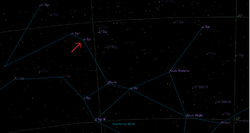いて座ο星ο Sagittarii
星座
いて座
見かけの等級 (mv )
3.77[ 1]
位置元期 :J2000.0
赤経 (RA, α)
19h 04m 40.9820400284s [ 2]
赤緯 (Dec, δ)
−21° 44′ 29.385451232″[ 2]
視線速度 (Rv)
26.1 ± 0.6 km/s[ 2]
固有運動 (μ)
赤経: 77.445 ± 0.187 ミリ秒 /年 [ 2] [ 2]
年周視差 (π)
23.8121 ± 0.1518ミリ秒[ 2]
距離
137 ± 0.9 光年 [ 注 1] パーセク [ 注 1]
絶対等級 (MV)
0.625[ 3]
いて座ο星の位置(矢印)
物理的性質
半径
11.7 ± 0.9 R ☉ [ 4]
質量
2.0 ± 0.3 M ☉ [ 4]
表面重力 (log g )
2.66 cgs [ 3]
スペクトル分類
G9 IIIb[ 1]
光度
67.6 L ☉ [ 5]
有効温度 (Teff
4,759 K [ 3]
色指数 (B-V)
1.01[ 1]
色指数 (U-B)
0.85[ 1]
色指数 (R-I)
0.53[ 1]
金属量 [Fe/H]
-0.04[ 3]
年齢
2.39× 10[ 5]
他のカタログ での名称
いて座39番星, ADS 11996, BD -21 5237, GJ 9641, HD 177241, HIP 93683, HR 7217, IRC -20536, SAO 187643[ 2]
■ Template (■ ノート ■ 解説) ■Project
いて座ο星 (いてざオミクロンせい、ο Sagittarii、ο Sgr)は、いて座 にある恒星 である[ 6] 見かけの等級 は3.77と、肉眼 でみえる明るさである[ 1] 年周視差 に基づいて太陽 からの距離を計算すると、約137光年 である[ 2] [ 注 1]
いて座ο星は、南斗六星 の北5度 くらいの辺り、黄道 のすぐ北に位置している[ 6] アステリズム と並ぶ、「ティースプーン」というアステリズムを、いて座π星 、いて座ξ星 (英語版 ) いて座d星 (英語版 ) いて座ρ1 星 (英語版 ) [ 7] [ 6] [ 注 2]
中国 ではいて座ο星は、太陽・月 ・惑星 が出入りする関所 、あるいは旗を表す建 拼音 : Jiàn 星官 を、いて座ξ2 星 (英語版 ) 1 星、いて座υ星 (英語版 ) [ 9] [ 10] 建二 (拼音 : Jiàn èr [ 9] [ 10]
いて座ο星は黄色巨星 で、スペクトル型 はG9 IIIbに分類される[ 1] レッドクランプ 巨星と位置づけられ、年齢はある程度以上古く、金属欠乏でもないことが示唆される[ 11] 金属量 は太陽との比較で9割程度とみられる[ 5] [ 3] 質量 は太陽 の2倍程度、半径 は太陽 の12倍程度まで広がり、光度 は太陽 のおよそ68倍、光球 の有効温度 は4759 K と見積もられている[ 4] [ 5] [ 3]
いて座ο星は、トーマス・シー によって「伴星」が発見され、二重星 とみなされている[ 12] [ 13] 秒 離れた位置にあるが、天の川 の中に位置するいて座ο星は周囲に無数の背景星があり、この「伴星」だけが物理的に関係があるとは考えづらく、いて座ο星は単独星の可能性が高いとされている[ 13] [ 6] [ 14]
^ a b c パーセクは1 ÷ 年周視差(秒)より計算、光年は1÷年周視差(秒)×3.2615638より計算
^ この「ティースプーン」というアステリズムにいて座υ星 (英語版 ) 古代ギリシア の影響を受ける以前のアラブ 文化では「弓」を意味する“al-qaus ”と呼ばれていたが、いて座が定着してからは al-quas が元となった“Kaus ”という固有名が、いて座δ星 (Kaus Media )、ε星 (Kaus Australis )、λ星 (Kaus Borealis )にあてられている[ 8]
^ a b c d e f g Hoffleit, D.; Warren, W. H., Jr. (1995-11), “Bright Star Catalogue , 5th Revised Ed.”, VizieR On-line Data Catalog: V/50 , Bibcode : 1995yCat.5050....0H
^ a b c d e f g h “omi Sgr -- High Proper Motion Star ”. SIMBAD CDS . 2024年3月1日 閲覧。
^ a b c d e f Liu, Y. J.; et al. (2007-12), “The abundances of nearby red clump giants”, Monthly Notices of the Royal Astronomical Society 382 (2): 553-566, Bibcode : 2007MNRAS.382..553L , doi :10.1111/j.1365-2966.2007.11852.x
^ a b c Cruzalèbes, P.; et al. (2013-09), “Fundamental parameters of 16 late-type stars derived from their angular diameter measured with VLTI/AMBER”, Monthly Notices of the Royal Astronomical Society 434 (1): 437-450, Bibcode : 2013MNRAS.434..437C , doi :10.1093/mnras/stt1037
^ a b c d Luck, R. Earle (2015-09), “Abundances in the Local Region. I. G and K Giants”, Astronomical Journal 150 (3): 88, Bibcode : 2015AJ....150...88L , doi :10.1088/0004-6256/150/3/88
^ a b c d Kaler, James B. (2017年9月1日). “OMI SGR (Omicron Sagittarii) ”. Stars . University of Illinois . 2024年3月1日 閲覧。
^ Lawrence, Pete (2022年6月28日). “A guide to the Teapot asterism ”. BBC Sky at Night Magazine2024年3月1日 閲覧。 ^ Kunitzsch, Paul ; Smart, Tim (2006). A Dictionary of Modern Star Names . Cambridge, MA : Sky & Telescope . pp. 51-52. ISBN 978-1-931559-44-7 ^ a b “中國古代的星象系統 (63): 斗宿天區 ” (中国語). AEEA 天文教育資訊網 . 國立自然科學博物館 (2006年7月2日). 2024年2月1日 閲覧。
^ a b Wylie, Alexander (1897). “Part III.—Scientific” . Chinese researches . Shanghai . p. 134. https://archive.org/details/in.ernet.dli.2015.279856
^ Alves, David R. (2000-08), “K-Band Calibration of the Red Clump Luminosity”, Astrophysical Journal 539 (2): 732-741, Bibcode : 2000ApJ...539..732A , doi :10.1086/309278 ^ See, T. J. J. (1898-03-28), “Discoveries and measures of double and multiple stars in the southern hemisphere”, Astronomical Journal 18 : 181-187, Bibcode : 1898AJ.....18..181S , doi :10.1086/102881 ^ a b Mason, Brian D.; et al. (2024-01), “The Washington Visual Double Star Catalog ”, VizieR On-line Data Catalog: B/wds , Bibcode : 2024yCat....102026M
^ Eggleton, P. P.; Tokovinin, A. A. (2008-09), “A catalogue of multiplicity among bright stellar systems”, Monthly Notices of the Royal Astronomical Society 389 (2): 869-879, Bibcode : 2008MNRAS.389..869E , doi :10.1111/j.1365-2966.2008.13596.x
“ARICNS 4C02788 ”. ARI Data Base for Nearby Stars . Astronomisches Rechen-Institut Heidelberg (1988年3月4日). 2024年3月1日 閲覧。 “ο Sagittarii ”. alcyone software. 2024年3月1日 閲覧。 座標 : 19h 04m 40.9820400284s , −21° 44′ 29.385451232″
